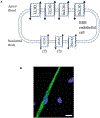Organic Cation Transporter (OCT/OCTN) Expression at Brain Barrier Sites: Focus on CNS Drug Delivery
- PMID: 33674914
- PMCID: PMC8603467
- DOI: 10.1007/164_2021_448
Organic Cation Transporter (OCT/OCTN) Expression at Brain Barrier Sites: Focus on CNS Drug Delivery
Abstract
Therapeutic delivery to the central nervous system (CNS) continues to be a considerable challenge in the pharmacological treatment and management of neurological disorders. This is primarily due to the physiological and biochemical characteristics of brain barrier sites (i.e., blood-brain barrier (BBB), blood-cerebrospinal fluid barrier (BCSFB)). Drug uptake into brain tissue is highly restricted by expression of tight junction protein complexes and adherens junctions between brain microvascular endothelial cells and choroid plexus epithelial cells. Additionally, efflux transport proteins expressed at the plasma membrane of these same endothelial and epithelial cells act to limit CNS concentrations of centrally acting drugs. In contrast, facilitated diffusion via transporter proteins allows for substrate-specific flux of molecules across the plasma membrane, directing drug uptake into the CNS. Organic Cation Transporters (OCTs) and Novel Organic Cation Transporters (OCTNs) are two subfamilies of the solute carrier 22 (SLC22) family of proteins that have significant potential to mediate delivery of positively charged, zwitterionic, and uncharged therapeutics. While expression of these transporters has been well characterized in peripheral tissues, the functional expression of OCT and OCTN transporters at CNS barrier sites and their role in delivery of therapeutic drugs to molecular targets in the brain require more detailed analysis. In this chapter, we will review current knowledge on localization, function, and regulation of OCT and OCTN isoforms at the BBB and BCSFB with a particular emphasis on how these transporters can be utilized for CNS delivery of therapeutic agents.
Keywords: Blood–Brain Barrier (BBB); Blood–Cerebrospinal Fluid Barrier (BCSFB); Brain parenchymal transporters; CNS drug delivery; Organic cation transport.
© 2021. The Author(s), under exclusive license to Springer Nature Switzerland AG.
Figures




Similar articles
-
Expression and function of organic cation and anion transporters (SLC22 family) in the CNS.Curr Pharm Des. 2014;20(10):1472-86. doi: 10.2174/13816128113199990456. Curr Pharm Des. 2014. PMID: 23789957 Review.
-
Organic Cation Transporter Expression and Function in the CNS.Handb Exp Pharmacol. 2021;266:41-80. doi: 10.1007/164_2021_463. Handb Exp Pharmacol. 2021. PMID: 33963461
-
The blood-brain and the blood-cerebrospinal fluid barriers: function and dysfunction.Semin Immunopathol. 2009 Nov;31(4):497-511. doi: 10.1007/s00281-009-0177-0. Epub 2009 Sep 25. Semin Immunopathol. 2009. PMID: 19779720 Review.
-
Blood-brain barrier transporters: a translational consideration for CNS delivery of neurotherapeutics.Expert Opin Drug Deliv. 2024 Jan-Jun;21(1):71-89. doi: 10.1080/17425247.2024.2306138. Epub 2024 Jan 31. Expert Opin Drug Deliv. 2024. PMID: 38217410 Free PMC article. Review.
-
Impact of transporters and enzymes from blood-cerebrospinal fluid barrier and brain parenchyma on CNS drug uptake.Expert Opin Drug Metab Toxicol. 2018 Sep;14(9):961-972. doi: 10.1080/17425255.2018.1513493. Epub 2018 Sep 5. Expert Opin Drug Metab Toxicol. 2018. PMID: 30118608 Review.
Cited by
-
Circadian ABCG2 Expression Influences the Brain Uptake of Donepezil across the Blood-Cerebrospinal Fluid Barrier.Int J Mol Sci. 2024 May 3;25(9):5014. doi: 10.3390/ijms25095014. Int J Mol Sci. 2024. PMID: 38732233 Free PMC article.
-
Blood-Brain Barrier Transporters: Opportunities for Therapeutic Development in Ischemic Stroke.Int J Mol Sci. 2022 Feb 8;23(3):1898. doi: 10.3390/ijms23031898. Int J Mol Sci. 2022. PMID: 35163820 Free PMC article. Review.
-
Emerging Roles of the Human Solute Carrier 22 Family.Drug Metab Dispos. 2021 Dec 17;50(9):1193-210. doi: 10.1124/dmd.121.000702. Drug Metab Dispos. 2021. PMID: 34921098 Free PMC article.
-
Delocalized quinolinium-macrocyclic peptides, an atypical chemotype for CNS penetration.Sci Adv. 2024 Jul 12;10(28):eado3501. doi: 10.1126/sciadv.ado3501. Epub 2024 Jul 10. Sci Adv. 2024. PMID: 38985859 Free PMC article.
-
Current Update on Transcellular Brain Drug Delivery.Pharmaceutics. 2022 Dec 5;14(12):2719. doi: 10.3390/pharmaceutics14122719. Pharmaceutics. 2022. PMID: 36559214 Free PMC article. Review.
References
MeSH terms
Substances
Grants and funding
LinkOut - more resources
Full Text Sources
Other Literature Sources
Medical

